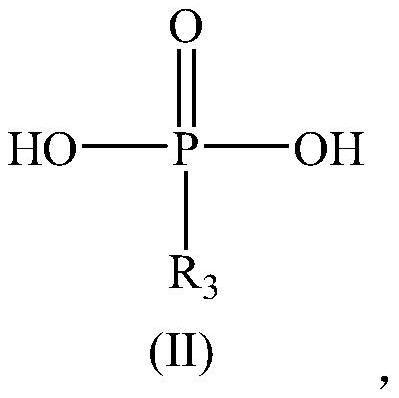A kind of phosphate ester modified cationic microgel, preparation method and application
A phosphate ester, microgel technology, applied in the field of polymers, can solve problems such as undiscovered
- Summary
- Abstract
- Description
- Claims
- Application Information
AI Technical Summary
Problems solved by technology
Method used
Image
Examples
Embodiment 1
[0069] In the first step, 740 parts of bisphenol A type epoxy resin (EEW=185), 37 parts MAP L-210 (common name laureth-1 phosphate) (Solvay (Solvay) company product, acid value is 180, and the quality of bifunctional phosphoric acid derivatives accounts for 5% of the quality of the first multifunctional epoxy resin. %) and 324 parts of bisphenol A were added to a 5L reactor, and then the reaction system was heated to 120°C. After the reaction raw materials are melted to form a transparent liquid, add 14.8 parts of triphenylphosphine (the quality of the alkali catalyst accounts for 2% of the mass of the first multifunctional epoxy resin), and the reaction system is heated up to 145 ° C, and kept at this temperature 2h. When the epoxy equivalent reaches the design value of 1200, the temperature of the reaction system is lowered to 110° C., and 275 parts of ethylene glycol butyl ether are added to reduce the viscosity to obtain a solid content of 80% of the main chain with epox...
Embodiment 2
[0073] In the first step, 740 parts of bisphenol A type epoxy resin (EEW=185), 74 parts of phenylphosphoric acid (molecular weight is 158, the quality of phosphoric acid derivative accounts for 10% of the quality of the first polyfunctionality epoxy resin) and Add 205 parts of bisphenol F into a 5L reactor, and then raise the temperature of the reaction system to 120°C. After the reaction raw materials are melted to form a transparent liquid, add 7.4 parts of tetrabutylphosphonium bromide (the quality of the base catalyst accounts for 1% of the first multifunctional epoxy resin quality), the reaction system is heated up to 140 ° C, and at this temperature Keep warm for 3h. When the epoxy equivalent reaches the design value of 1000, the temperature of the reaction system is lowered to 110° C., and 340 parts of diethylene glycol butyl ether is added to reduce the viscosity, so that a solid content of 75% is obtained. 1. A macromolecular epoxy resin containing phosphate repeatin...
Embodiment 3
[0077]In the first step, 740 parts of bisphenol A type epoxy resin (EEW=185), 7.4 parts of butyl phosphoric acid (molecular weight is 136, the quality of phosphoric acid derivative accounts for 1% of the quality of the first polyfunctional epoxy resin) and 240 parts of bisphenol S were added into a 5L reactor, and then the temperature of the reaction system was raised to 120°C. After the reaction raw materials are melted to form a transparent liquid, add 0.74 parts of N,N-dimethylbenzylamine (the mass of the base catalyst accounts for 0.1% of the mass of the first multifunctional epoxy resin), raise the temperature of the reaction system to 160°C, and Insulate at this temperature for 4h. When the epoxy equivalent reaches the design value of 500, the temperature of the reaction system is lowered to 110° C., and 635 parts of propylene glycol methyl ether is added to reduce the viscosity, so that a solid content of 60% is obtained. A macromolecular epoxy resin containing phospha...
PUM
 Login to View More
Login to View More Abstract
Description
Claims
Application Information
 Login to View More
Login to View More - R&D
- Intellectual Property
- Life Sciences
- Materials
- Tech Scout
- Unparalleled Data Quality
- Higher Quality Content
- 60% Fewer Hallucinations
Browse by: Latest US Patents, China's latest patents, Technical Efficacy Thesaurus, Application Domain, Technology Topic, Popular Technical Reports.
© 2025 PatSnap. All rights reserved.Legal|Privacy policy|Modern Slavery Act Transparency Statement|Sitemap|About US| Contact US: help@patsnap.com



